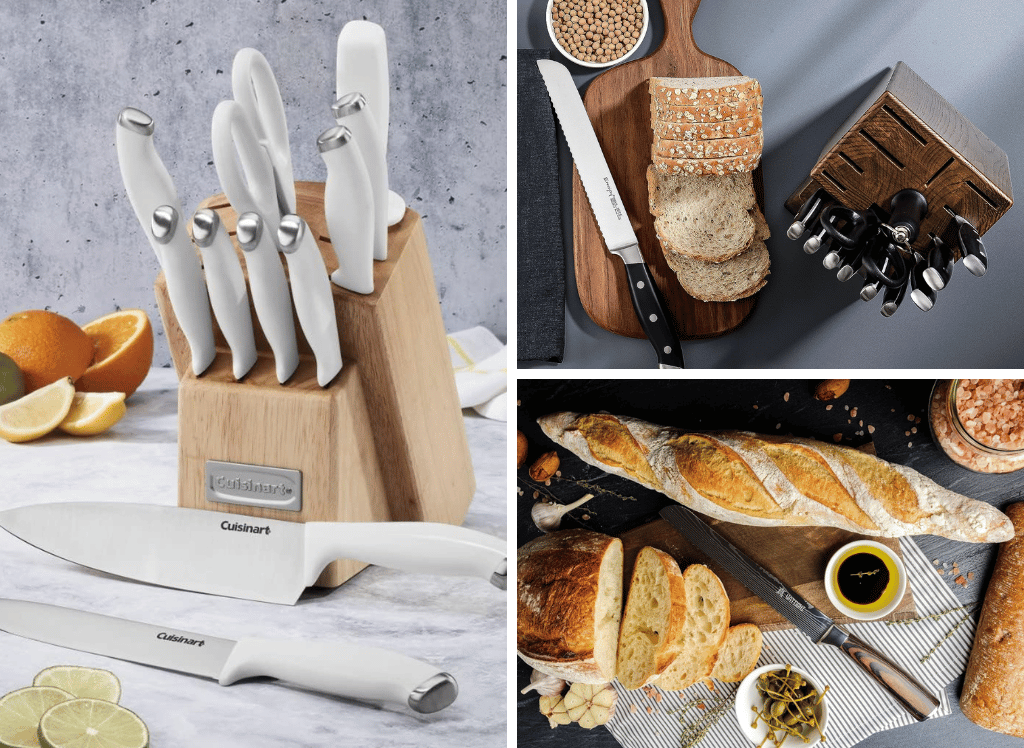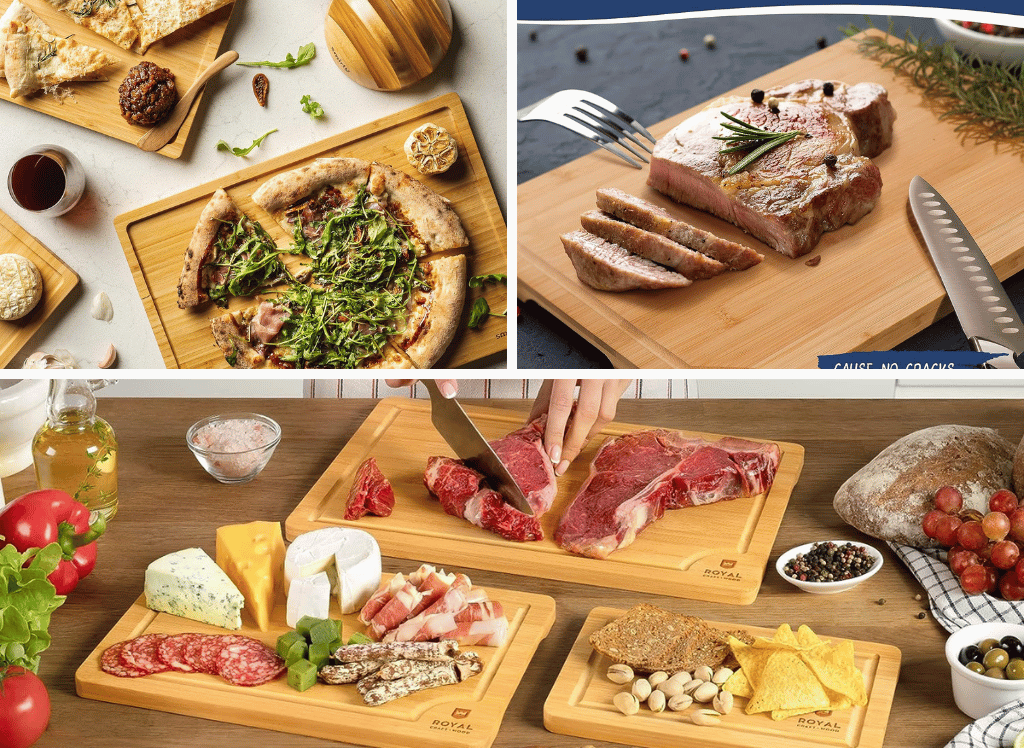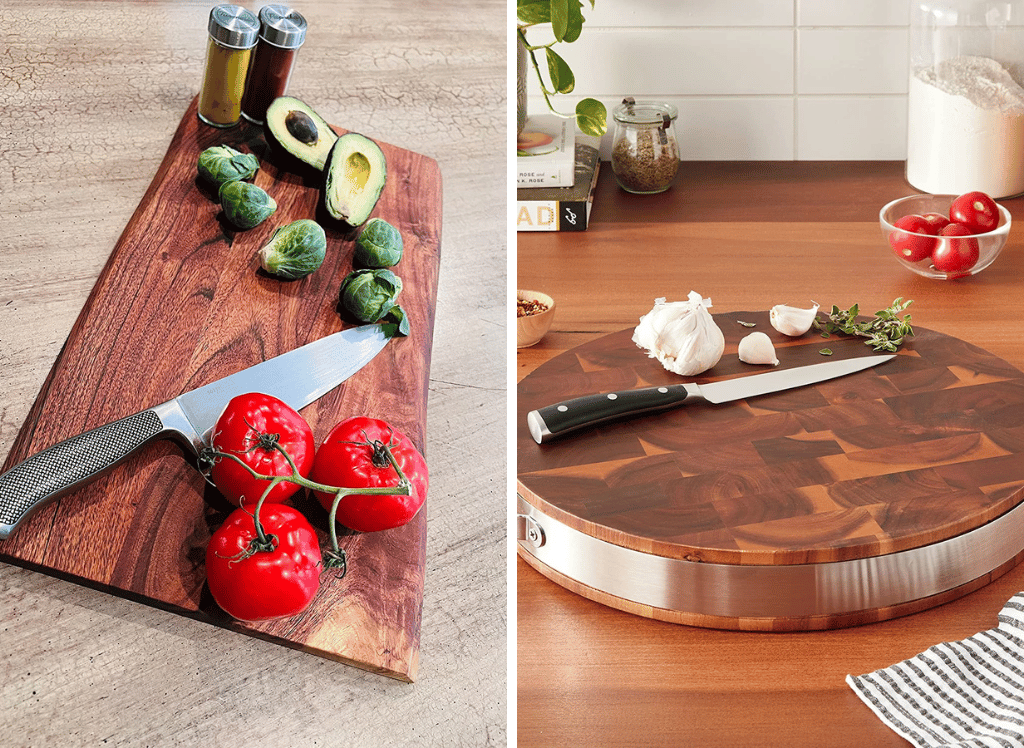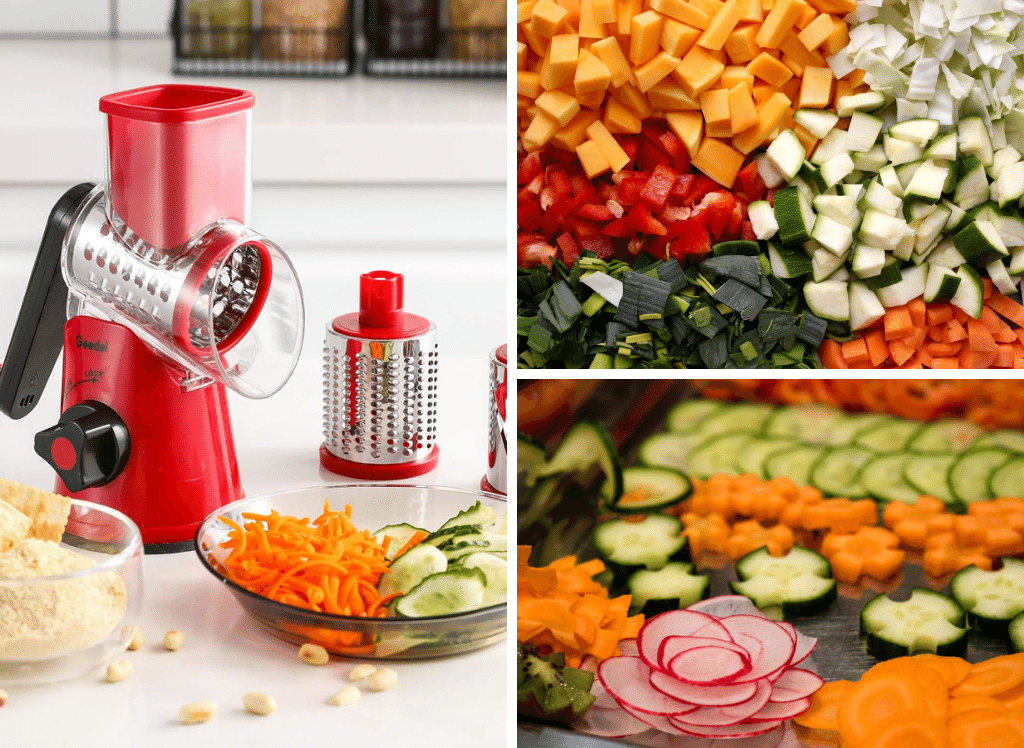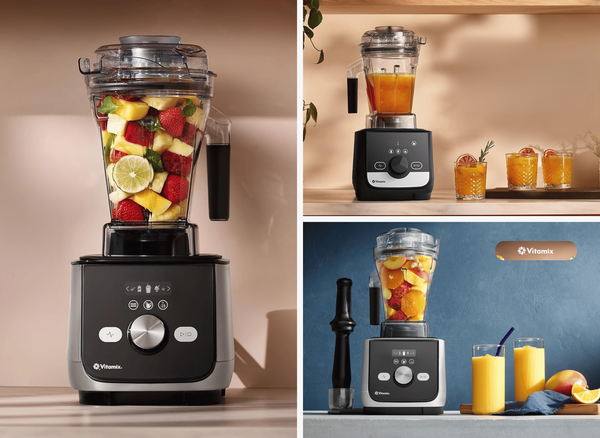Welcome to FactsFanatics. As an Amazon Associate, we earn from qualifying purchases (at no cost to you) from links found within these pages if you choose to buy something.
The price of Japanese kitchen knives reflects centuries of craftsmanship and culinary tradition, drawing many enthusiasts who are interested in high-quality cooking tools. The country of origin, Japan, is renowned for its traditional craftsmanship and quality standards in kitchen knives.
These precision instruments have earned their place in both professional kitchens and home cooking spaces worldwide. Their exceptional sharpness, elegant design, and superior performance make them essential tools for anyone serious about cooking.
Unlike Western-style knives, the art of Japanese knife-making combines Japan's long-standing tradition and expertise with modern innovation. Each blade tells a story of meticulous craftsmanship, where form meets function in perfect harmony. Whether you’re a professional chef seeking precision or a home cook looking to elevate your culinary skills, understanding Japanese knives and utilizing professional sharpening services can transform your cooking experience.
This detailed guide explores everything you need to know about Japanese kitchen knives, including their series and types. Learn more about the unique qualities and history of Japanese kitchen knives as you read. From their rich history to choosing the perfect blade for your needs, we’ll cover the essential knowledge that will help you make informed decisions about these remarkable tools.
Introduction to Japanese Knives
Japanese knives, often referred to as versatile knives, are considered among the best in the world, celebrated for their razor-sharp edges, lightweight construction, and exquisite design. With a heritage that spans hundreds of years, Japanese knife brands have refined their craft to produce cutlery that suits a wide range of kitchen tasks.
Each knife, whether it’s the versatile chef's knife, the specialized deba for fish, or the best nakiri for vegetables, is meticulously shaped and balanced to deliver perfect precision and beauty, making the chef's knife essential in any kitchen. The thoughtful design of these knives ensures a perfect balance between form and function, making them a proud symbol of Japan’s culinary tradition and a sought-after tool for chefs and home cooks around the world.
Benefits of Japanese Knives
The advantages of Japanese knives, including their blade material, go far beyond their striking appearance. Designed for ease and smooth, precise slicing, these knives make every kitchen task feel effortless. Their lightweight build reduces hand fatigue, allowing you to work quickly and comfortably, making quick work of your cooking tasks, whether you’re preparing a simple meal at home or working in a professional kitchen.
The combination of high-quality steel and time-honored craftsmanship means Japanese knives hold their razor-sharp edge longer, requiring less frequent sharpening. This level of performance and beauty is hard to find elsewhere, making Japanese knives an excellent investment for anyone who values both function and aesthetics in their kitchen tools.
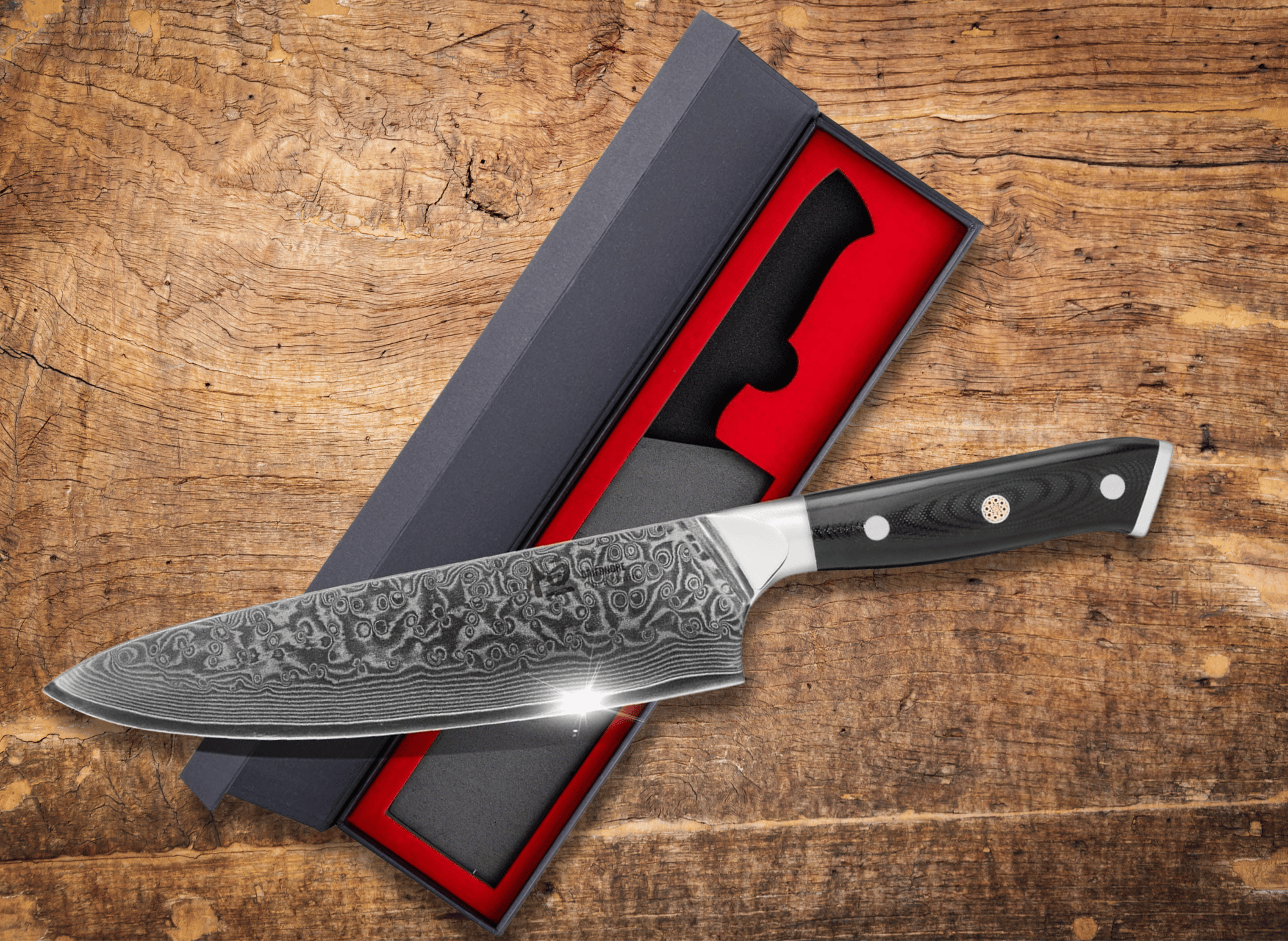
GAIFONGRE 8 Inch Japanese Steel Damascus Kitchen Knife
VG-10 Damascus Super Steel Kitchen Knife, Ultra Sharp Professional Cooking Knife with Ergonomic G10 Handle,Including Luxury Gift Box
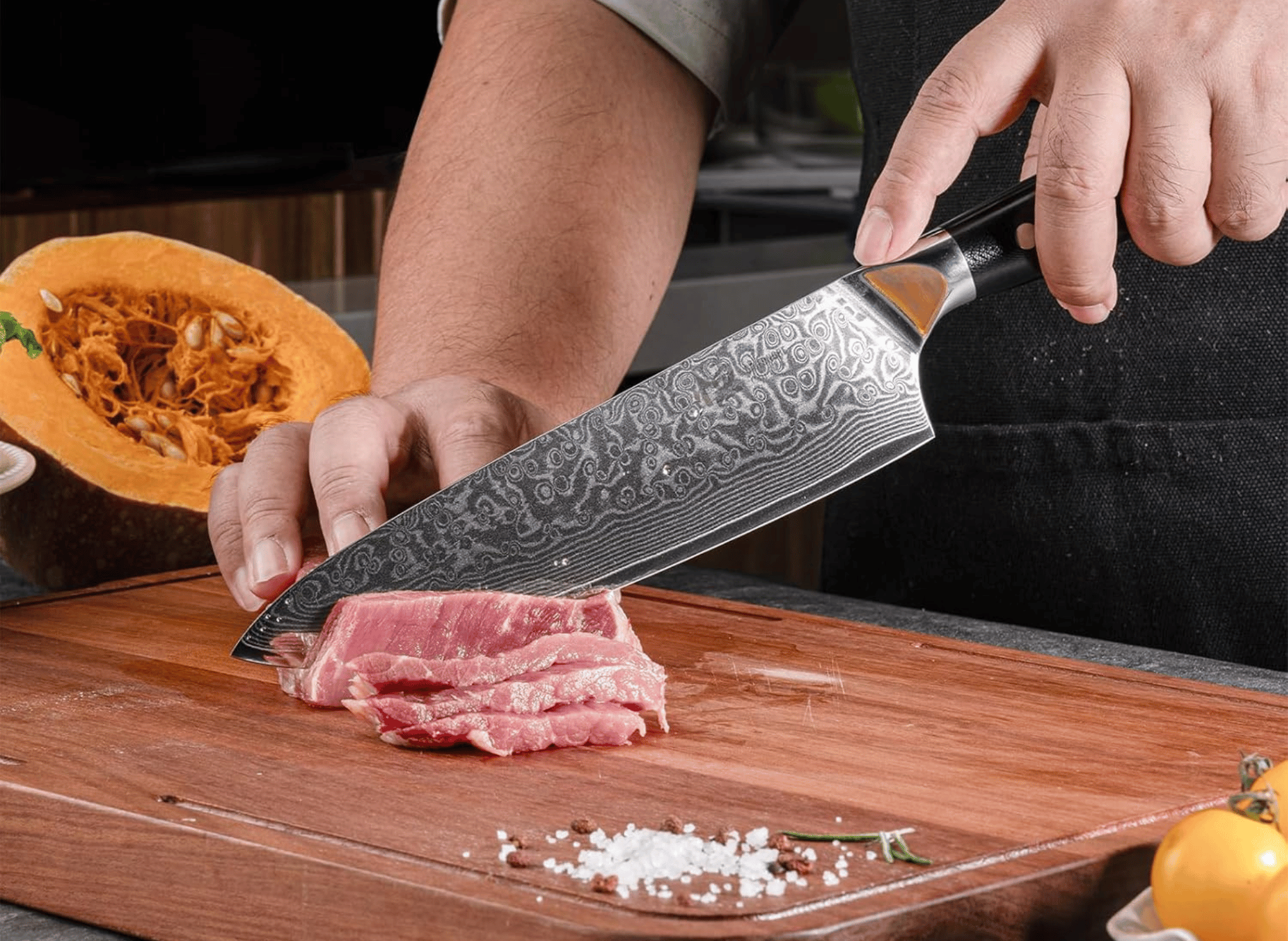
GAIFONGRE 8-Inch Japanese Steel Damascus Kitchen Knife
- Unmatched Sharpness: Featuring a VG-10 steel core and an impressive hardness of 62 HRC, this razor-sharp blade ensures effortless slicing and dicing without losing its edge, saving you time and effort.
- Durable 67-Layer Damascus Steel: The stunning layered pattern not only catches the eye but also delivers superior toughness and rust resistance, making it perfect for tackling daily culinary tasks with ease.
- Ergonomic G10 Glass Fiber Handle: Designed for ultimate comfort, the handle offers excellent grip, insulation, and resistance to wear and corrosion, ensuring hours of fatigue-free cooking.
- Versatility in the Kitchen: This knife excels at an array of tasks including slicing vegetables, cutting meats, preparing sushi, and even crafting artisanal bread. It’s a true all-rounder for professionals and home cooks alike.
- Masterful Craftsmanship: Enhanced by wax polishing technology, the knife combines timeless aesthetic appeal with durability and strength, elevating both performance and style in your kitchen.
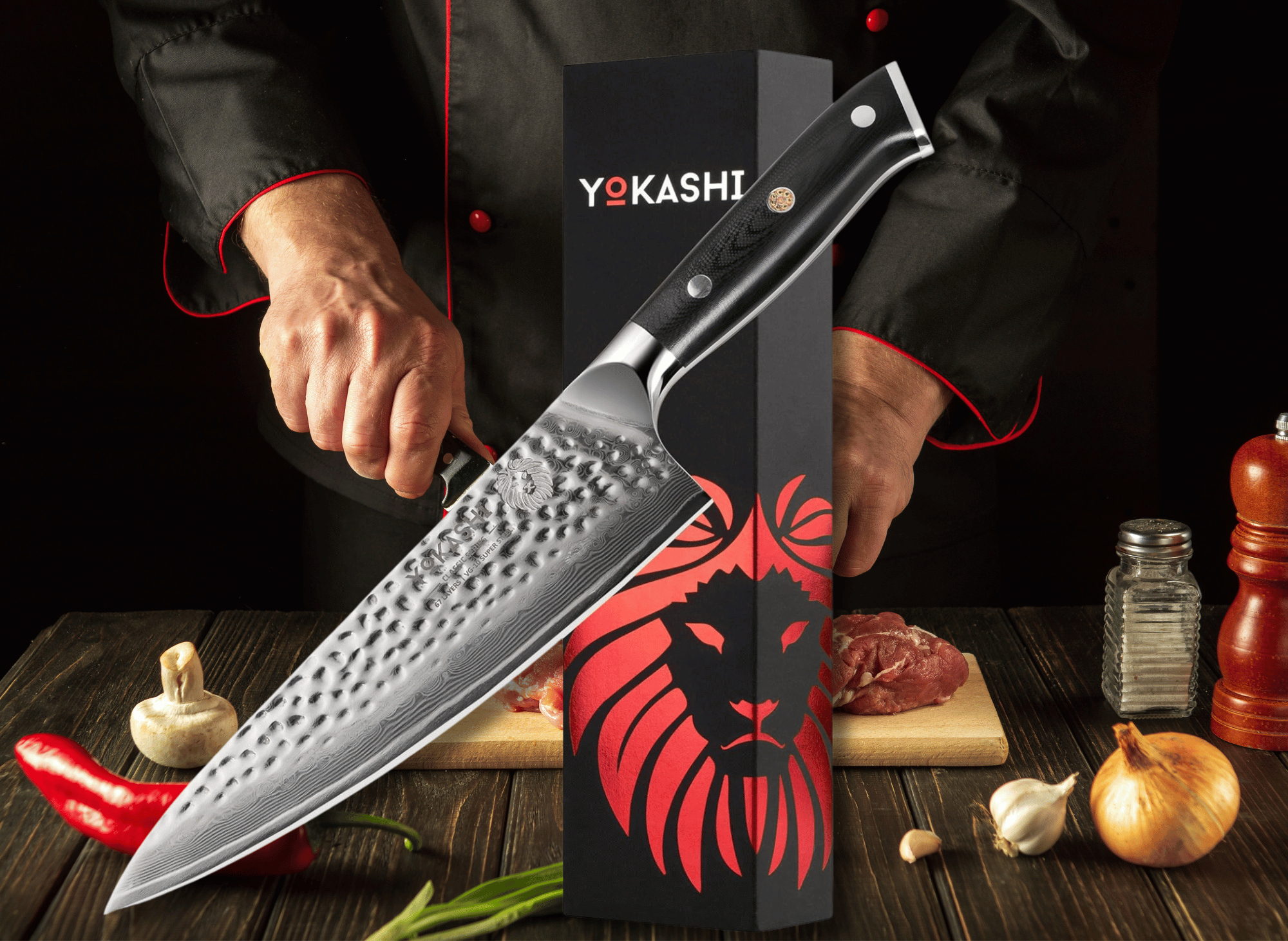
YOKASHI Japanese Damascus Chef Knife
8-Inch Professional VG-10 High-Carbon Steel Kitchen Knife – Razor-Sharp Japanese Knife for Chefs and Home Cooks, Ideal for Chopping, Slicing, and Dicing
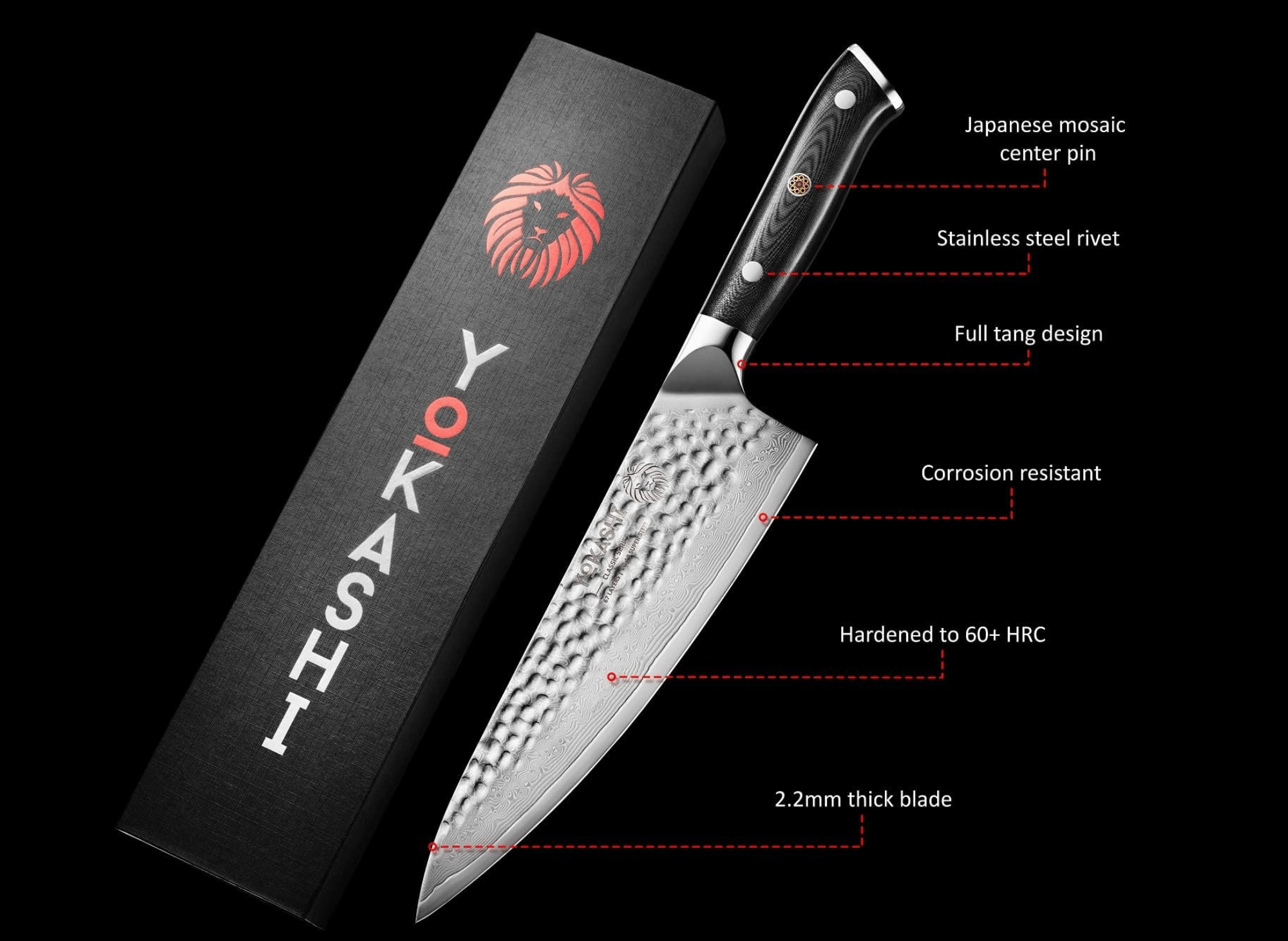
YOKASHI Damascus Chef Knife
- Exceptional Sharpness: The Damascus steel blade ensures superior sharpness, allowing for precise and effortless cutting, slicing, and chopping.
- Durability and Strength: Crafted from high-quality materials, the knife is built to last, maintaining its edge even after extended use.
- Ergonomic Design: The handle is carefully engineered for comfort and a secure grip, reducing hand fatigue during prolonged use.
- Versatile Functionality: Perfect for a wide range of tasks, from preparing delicate ingredients to heavy-duty cutting.
- Elegant Presentation: The intricate Damascus pattern and sleek design make this knife a beautiful addition to any kitchen.
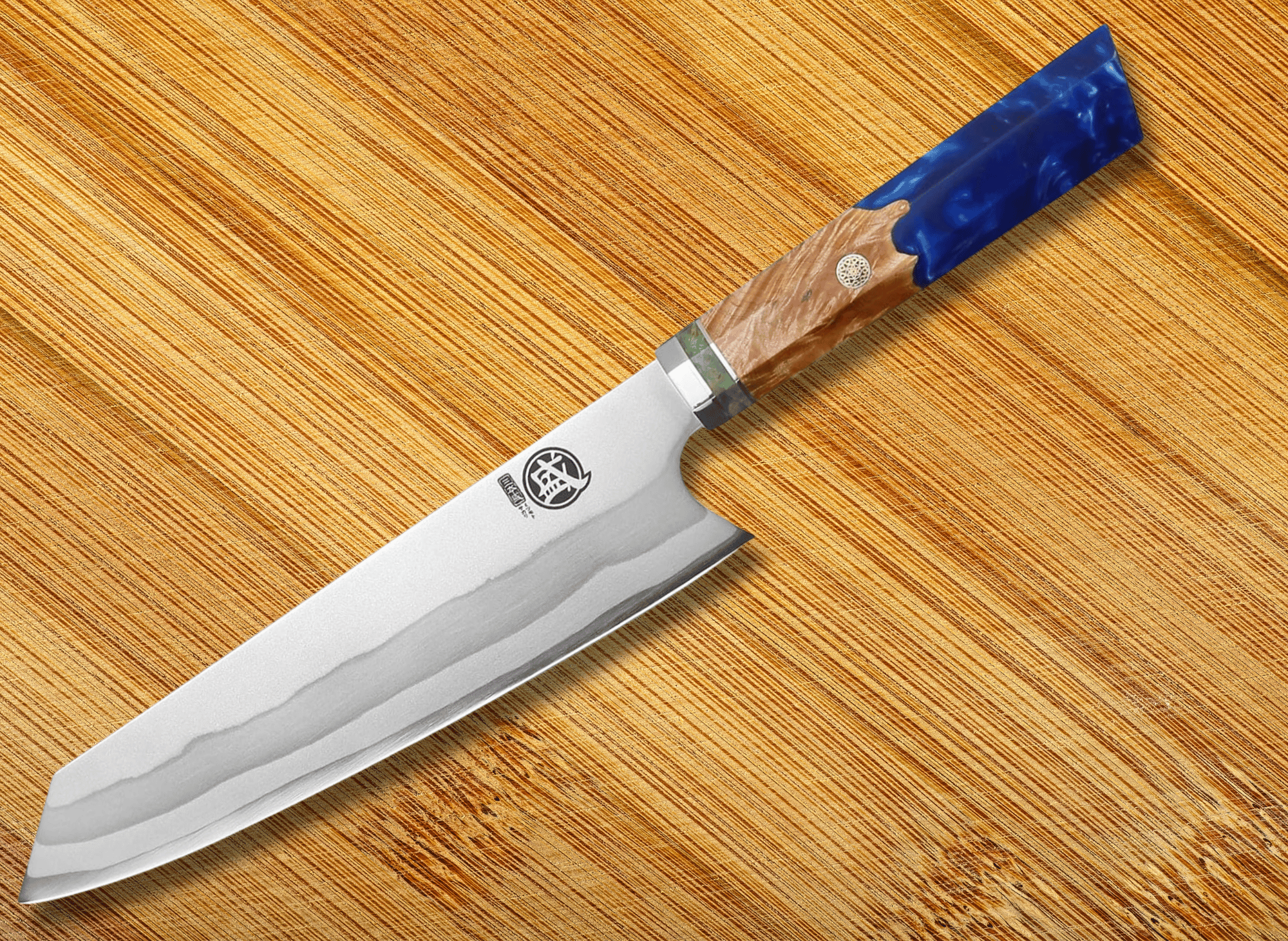
MITSUMOTO SAKARI 8-inch Japanese Kiritsuke Chef Knife
Hand Forged 67 Layers 440C Damascus Steel Kitchen Knives, Professional Meat Sushi Chef's Knife (Blue Pomegranate Handle & Sandalwood Box)
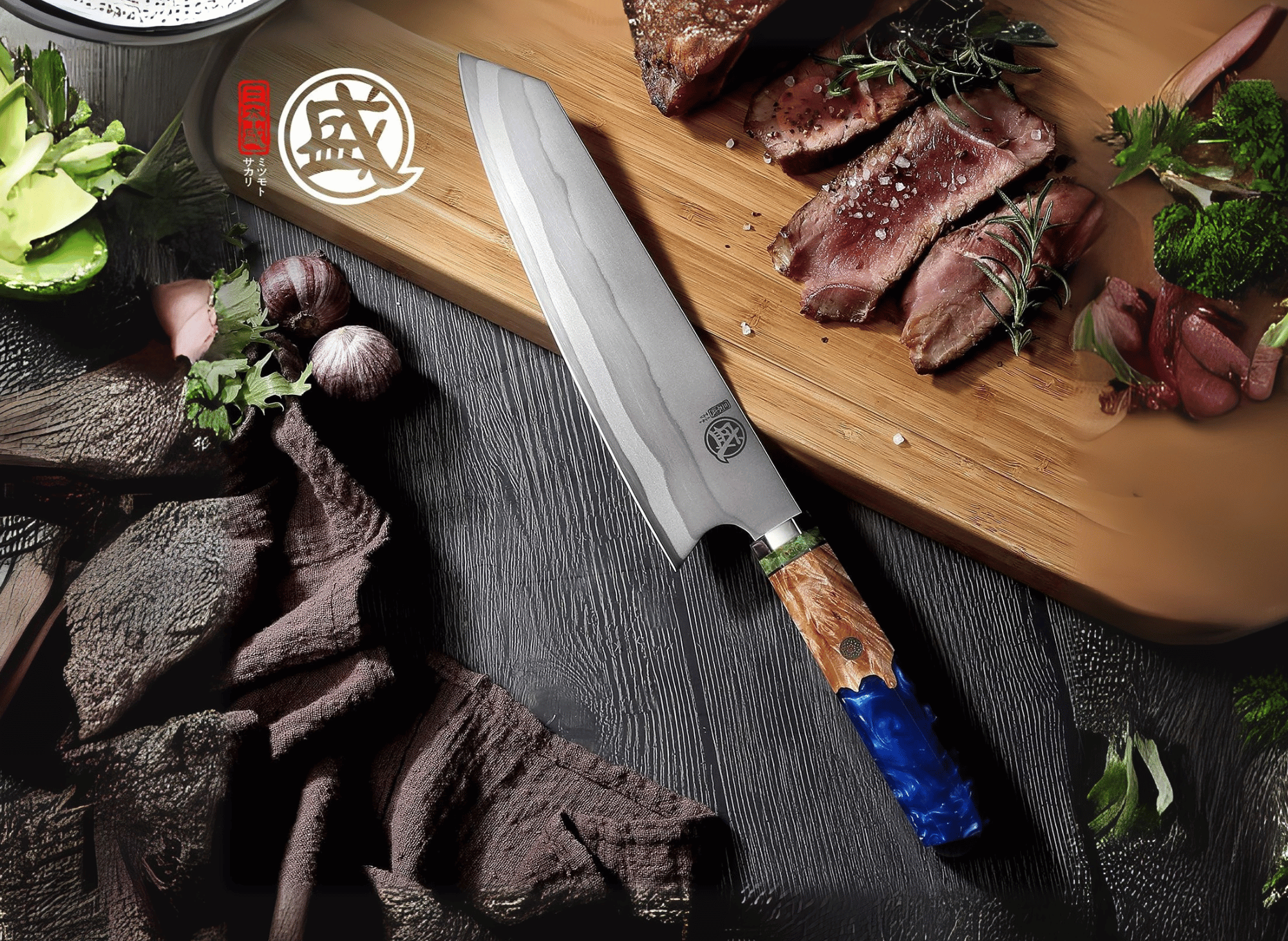
MITSUMOTO SAKARI 8-inch Japanese Kiritsuke Chef Knife
- Exceptional Sharpness: The ultra-sharp blade ensures precise and effortless cutting, slicing, and dicing of a wide range of ingredients.
- Durable High-Carbon Steel: Crafted from premium high-carbon steel, the blade offers superior durability and resilience, maintaining sharpness over prolonged use.
- Ergonomic Design: The optimal curvature and balanced design provide a comfortable and secure grip, reducing hand fatigue during extended use.
- Aesthetic Appeal: The beautifully crafted sandalwood case and elegant finish make this knife a perfect choice for gifting or showcasing in professional kitchens.
- Professional-Grade Performance: Ideal for both home cooks and professional chefs, the knife delivers consistent, high-quality results for any culinary task.
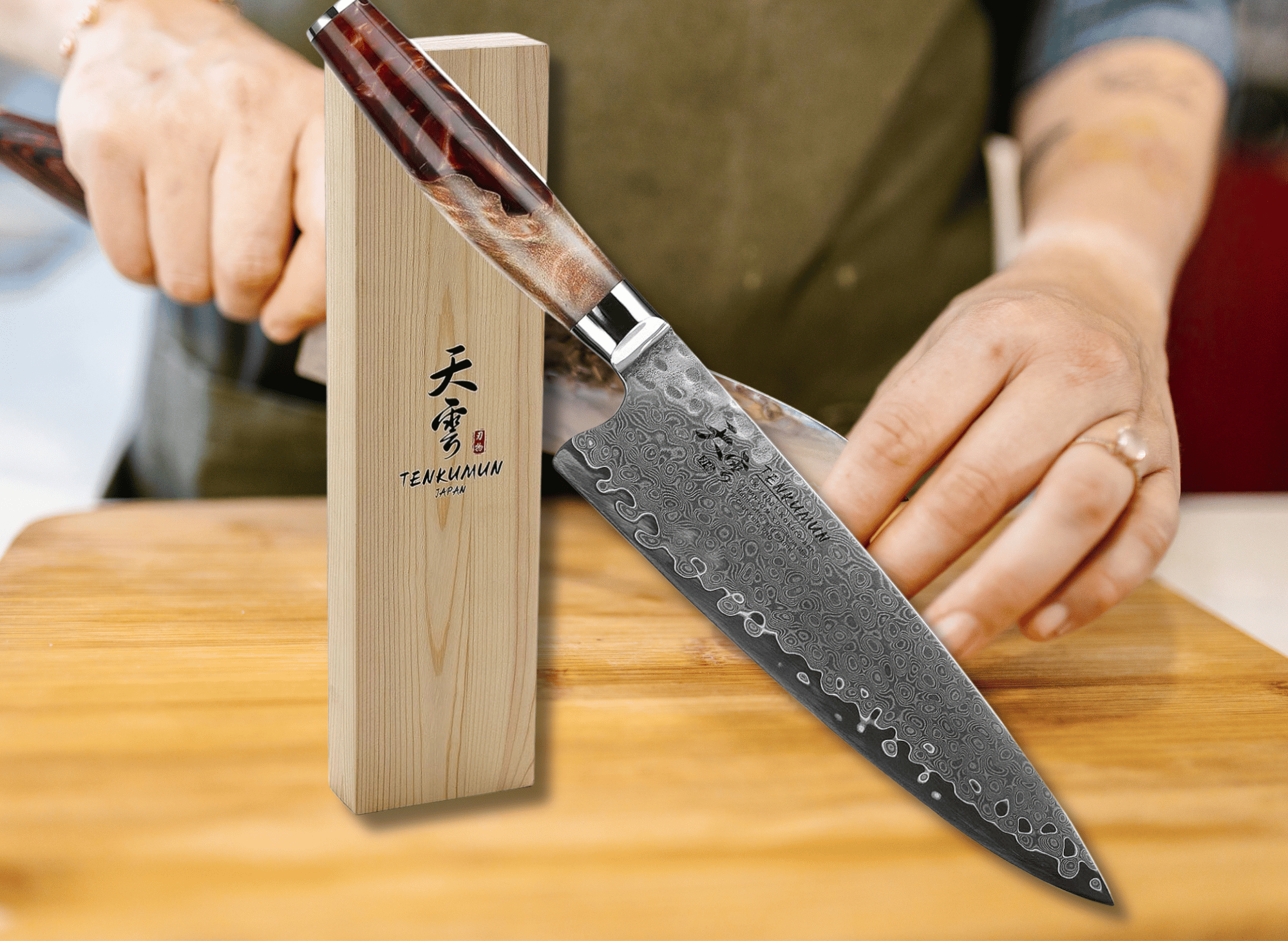
Tenkumun Japanese Gyutou Pro. Handcrafted 8-inch Chef Knife
Handmade Forged Knife Japan VG-10 MAX Damascus Steel -Kokoro ser. with Wood Handle
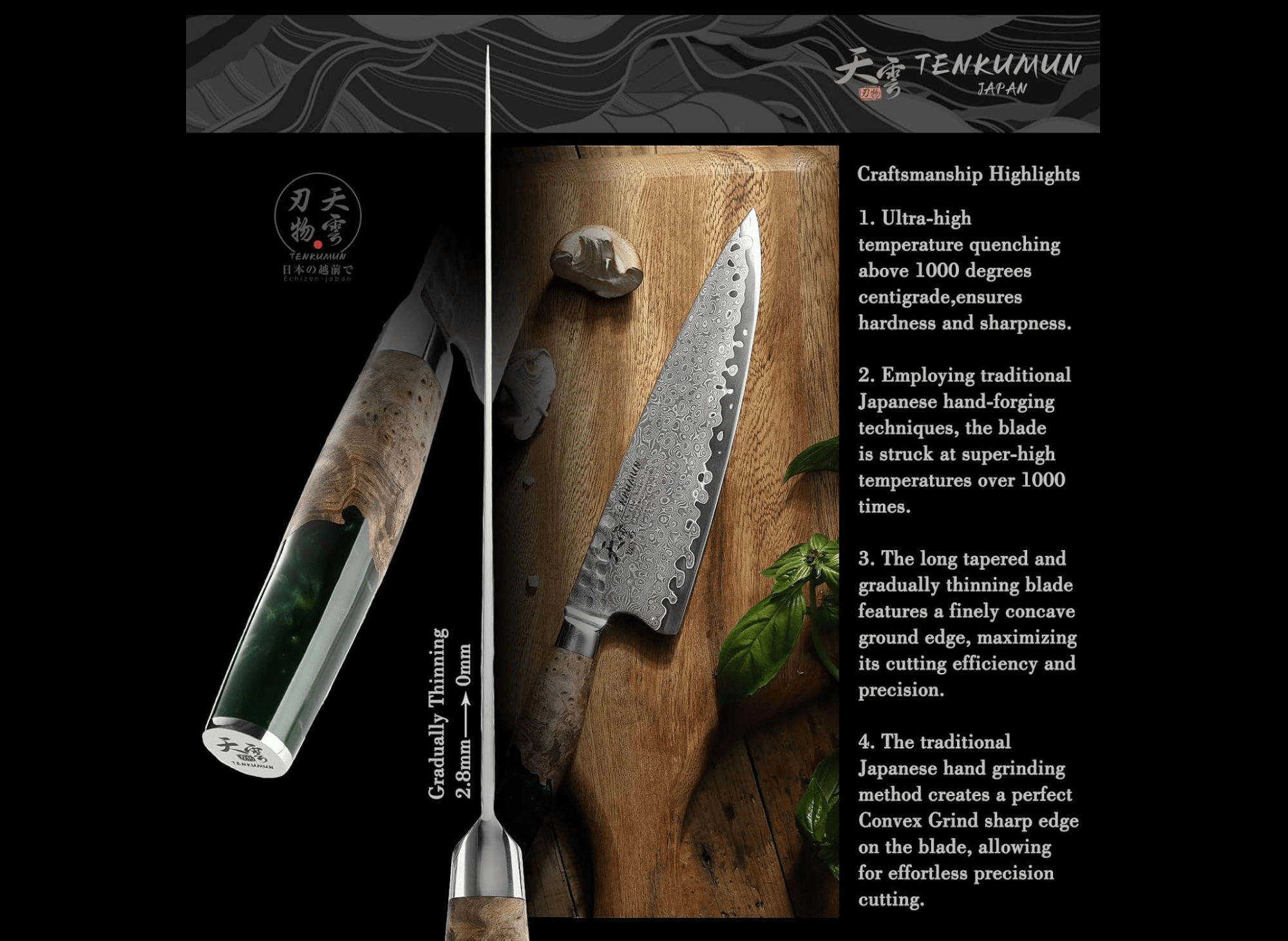
Tenkumun Japanese Gyutou Pro. Handcrafted 8-inch Chef Knife
- Unparalleled Sharpness: Each "Tenkumun" chef's knife is meticulously crafted, ensuring an exceptionally sharp blade that allows for effortless cutting and slicing, thereby enhancing both safety and efficiency in the kitchen.
- Superior Durability: Using high-quality materials and expert craftsmanship, these knives are built to last. They maintain their sharpness longer and resist wear, making them a reliable tool for years to come.
- Ergonomic Design: Designed with user comfort in mind, "Tenkumun" knives feature an ergonomic handle that provides a secure grip and reduces hand fatigue, even during extended cooking sessions.
- Versatile Functionality: Whether you’re a professional chef or a home cook, our knives cater to a wide range of culinary tasks, from fine dicing to robust chopping, making them a valuable addition to any kitchen.
- Aesthetically Pleasing: With their seamless blend of traditional Japanese design and modern elegance, "Tenkumun" knives are not only functional tools but also a statement piece, adding a touch of sophistication to your kitchen.
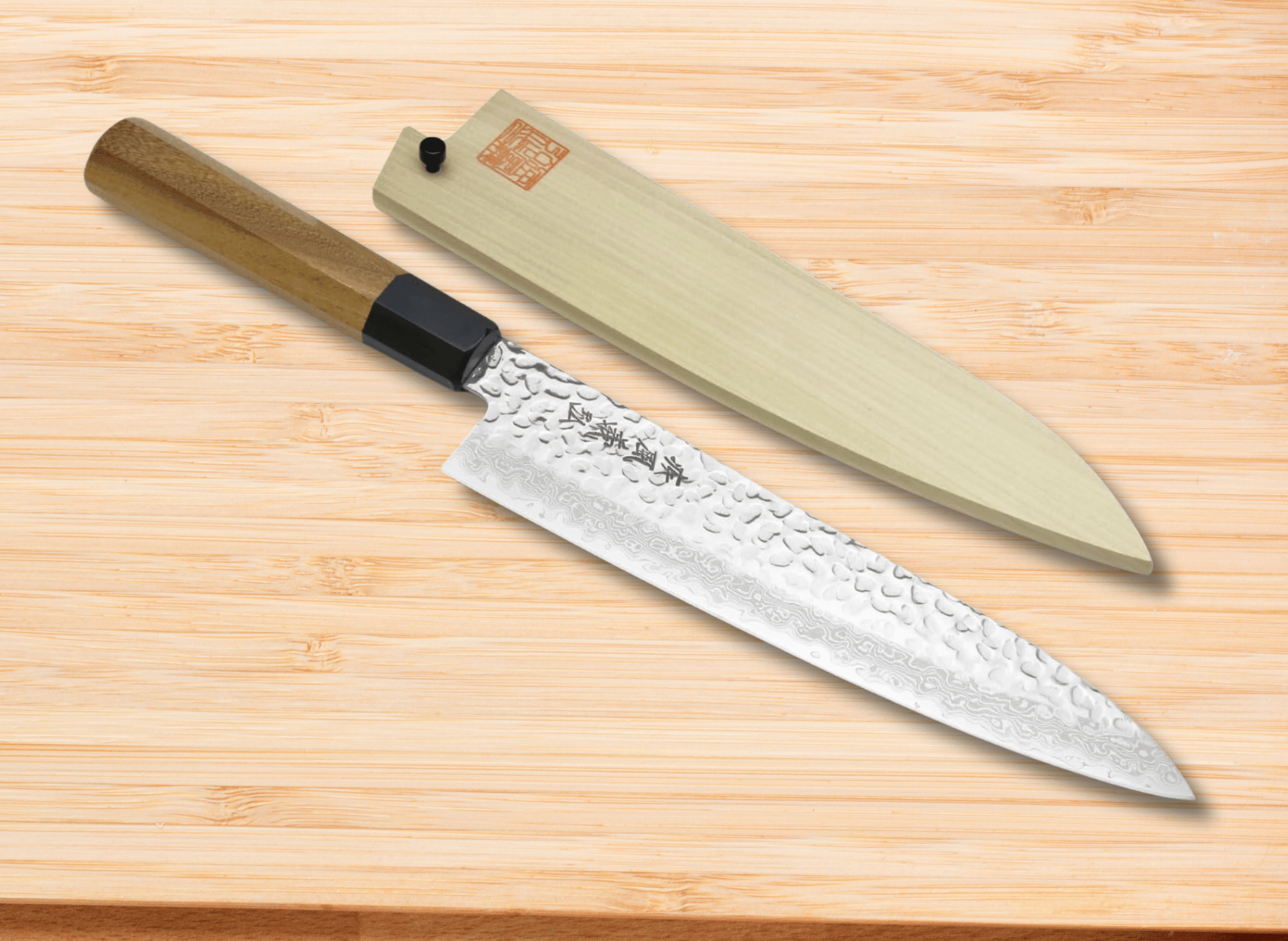
Yoshihiro VG10 46 Layers Hammered Damascus Gyuto Japanese Chefs Knife
(Octagonal Ambrosia Handle) (8.25" (210mm)
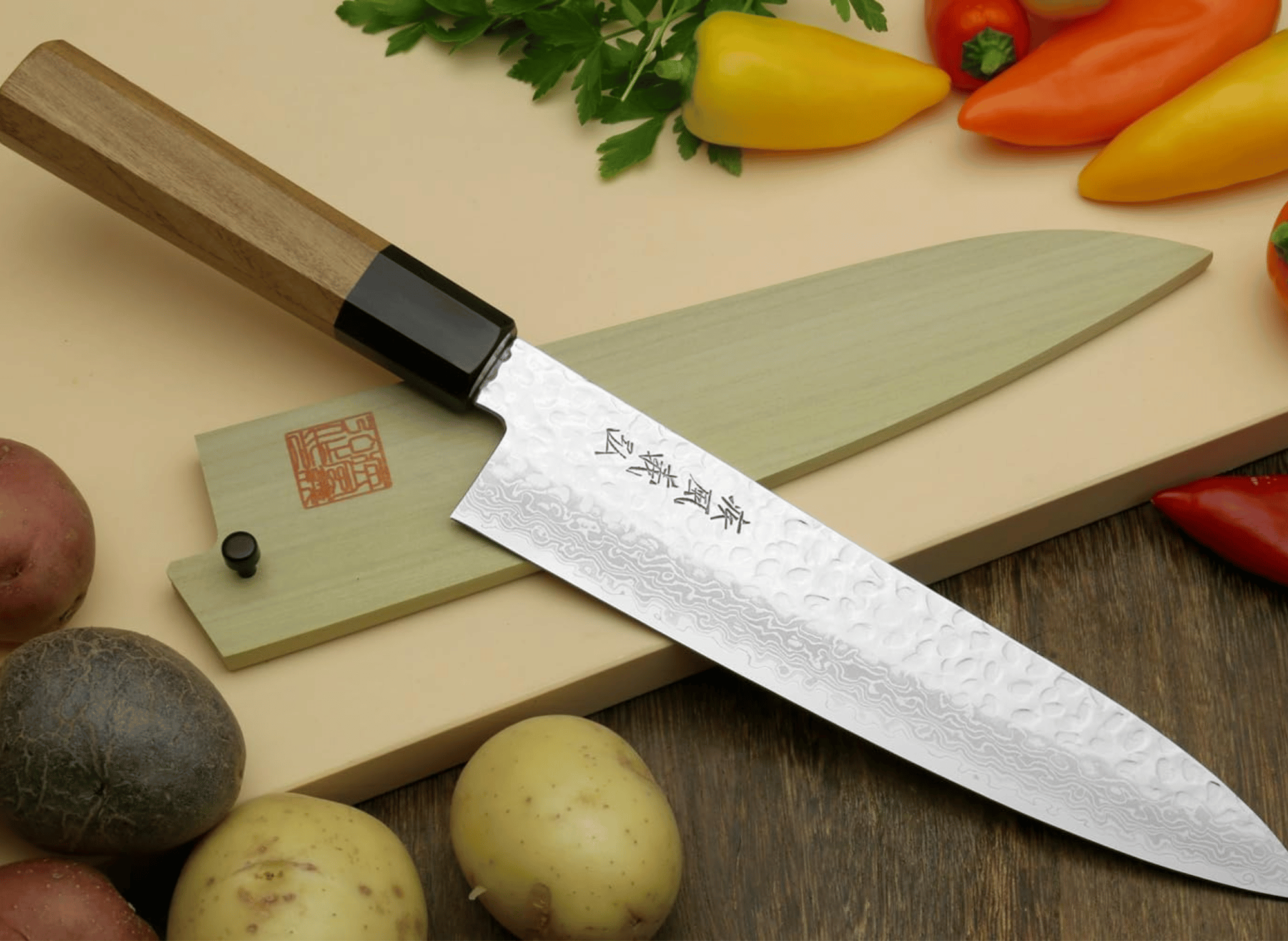
Yoshihiro VG10 46 Layers Hammered Damascus Gyuto Japanese Chefs Knife
- Exceptional Sharpness: The knife’s sharp edge allows for precision cutting, making it ideal for tasks that require intricate and accurate slicing.
- Durability: Crafted with high-quality materials, the knife is designed to withstand regular use while maintaining its performance.
- Aesthetic Appeal: The hammered texture and elegant design provide a visually striking appearance that complements any kitchen.
- Improved Cutting Efficiency: The unique blade texture reduces friction and prevents food from sticking, ensuring smoother and faster cutting.
- Authenticity: Rooted in traditional Japanese craftsmanship, the knife offers an authentic culinary experience.
The Rich History of Japanese Knife Craftsmanship
The hardness of the steel used in Japanese knife-making dates back over 1,000 years to the era of samurai swords. The tradition of knives made in Japan dates back to when master swordsmiths, renowned for crafting samurai swords, applied their legendary forging techniques to kitchen knives, transferring their expertise from weapons to culinary tools. This transition happened during the Meiji Restoration in the late 1800s when carrying swords became illegal.
The city of Sakai, located near Osaka, has experimented with various methods and has become the epicenter of Japanese knife production. Sakai’s craftsmen developed unique techniques that set Japanese knives apart from their Western counterparts. There are key differences between Japanese and Western knives, particularly in blade design and sharpening techniques. Japanese knives often feature thinner, harder blades and are sharpened at more acute angles for greater precision.
Traditional Japanese knives were single-beveled, meaning they were sharpened on only one side of the blade. This design enabled precise cuts and was tailored to the Japanese cooking style, which emphasizes the clean, delicate preparation of ingredients such as fish and vegetables.
A Japanese kitchen knife crafted with precision by Takeshi Saji is the perfect tool for sushi enthusiasts. Originating from Sakai City, renowned for its knife-making tradition, this knife is essential for any culinary artist.
Modern Japanese knife-making has evolved to incorporate both traditional single-bevel designs and Western-style double-bevel knives, which can enhance your cooking experience. This evolution has made Japanese knives more accessible to Western cooks while maintaining their superior sharpness and quality.
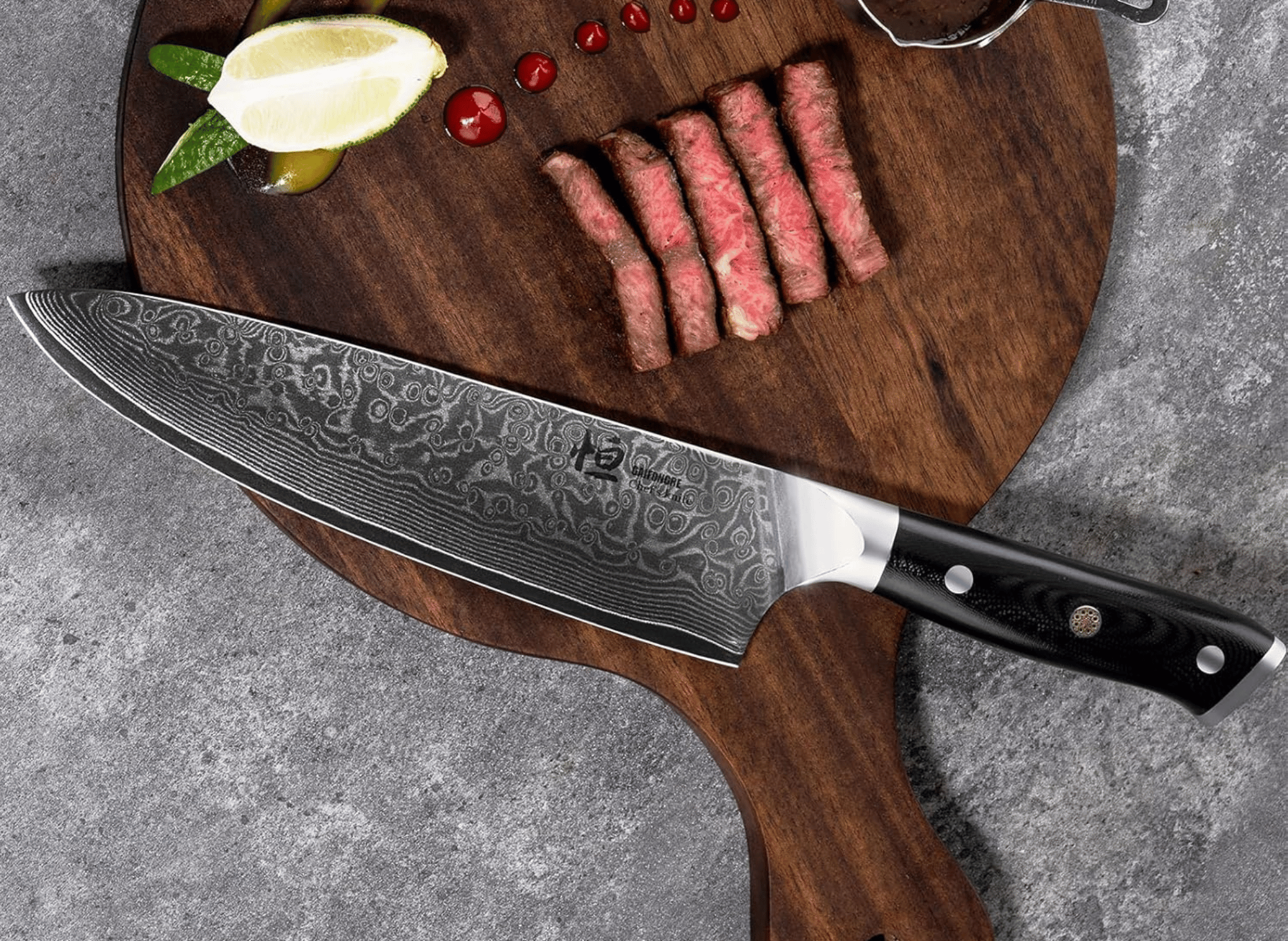
Essential Types of Japanese Kitchen Knives
Chef's Knife (Gyuto)
The Gyuto is the Japanese equivalent of a Western chef’s knife and, as part of a series of Japanese knives, is the most versatile blade in any kitchen. Its name means “cow sword,” reflecting its original purpose for cutting meat. Modern Gyuto knives typically range from 210mm to 270mm in length.
This knife excels at chopping vegetables, slicing meat, and performing a variety of general kitchen tasks. The Gyuto’s profile allows for both push-cutting and rocking motions, making it adaptable to various cooking styles. Its thinner blade compared to Western chefs’ knives provides cleaner cuts with less food sticking to the surface.
For home cooks starting their Japanese knife collection, the Gyuto and nakiri knives offer the best combination of versatility and functionality. It can handle approximately 80% of kitchen tasks, making it an excellent investment for serious cooking enthusiasts. As your skills develop, you can add other Japanese knife types, such as Santoku or specialized blades for filleting fish, to your collection.
Vegetable Knife (Nakiri & Usuba)
The Nakiri and Usuba are specialized vegetable knives with distinct characteristics, and understanding the differences between them is essential for selecting the right knife for your needs. The main differences are in their edge design: the Nakiri features a double-bevel edge, making it more suitable for home cooks, while the Usuba has a single-bevel edge preferred by professional chefs.
These knives feature a rectangular blade shape that provides maximum contact with the cutting surface of vegetables, allowing for efficient and precise cutting. This design ensures clean cuts without crushing delicate produce. The flat edge makes them perfect for chopping, dicing, and julienning vegetables with precision.
The Nakiri typically measures between 160mm and 180mm, making it comfortable for extended use. Its weight distribution and balance make vegetable preparation effortless and enjoyable, reducing fatigue during long cooking sessions.
Petty Knife (Utility Knife)
The Petty knife serves as the Japanese equivalent of a paring knife but with enhanced capabilities. Ranging from 120mm to 180mm, it handles detail work that larger knives cannot manage effectively. Its sharp point and nimble size make it perfect for intricate work that requires control and accuracy.
When choosing a Petty knife, it is essential to select the right size to suit your specific kitchen tasks, ensuring optimal performance and comfort. Many professional chefs consider the Petty knife their second most important tool after the Gyuto. Its versatility in handling small tasks makes it an indispensable addition to any knife collection.
Slicing Knife (Sujihiki)
The Sujihiki is a long, narrow knife explicitly designed for slicing cooked meats and fish. Its length typically ranges from 240mm to 300mm, allowing for long, smooth cuts without sawing motions.
This knife’s thin profile and sharp edge create clean slices that preserve the meat’s texture and appearance. The double-bevel sides of the Sujihiki contribute to its ability to produce precise, even slices with minimal resistance, making it suitable for both right- and left-handed users. The Sujihiki is essential for carving roasts, slicing sashimi, and portioning large fish fillets.
Professional chefs value the Sujihiki for its ability to create paper-thin slices and its efficiency in breaking down significant cuts of meat. Its specialized design makes it irreplaceable for specific tasks requiring precision slicing.
Deba Knife
The Deba is a heavy, single-bevel knife designed for breaking down whole fish. Its thick spine and robust construction allow it to cut through fish bones and cartilage while maintaining precision for delicate filleting work. The Deba's sturdy design also makes it suitable for breaking down poultry, offering the weight and control needed for tasks like filleting and deboning poultry meat.
Traditional Deba knives range from 150mm to 210mm, with the size choice depending on the typical size of the fish being processed. The knife’s weight and balance provide the leverage needed for efficient fish butchery.
The Deba requires specific techniques and maintenance due to its single-bevel design. While specialized, it remains essential for anyone regularly preparing whole fish or interested in traditional Japanese fish preparation methods.
Choosing the Right Japanese Knife
With so many shapes, sizes, and styles available, finding the right Japanese knife can seem daunting. Start by considering the kitchen tasks you perform most often. For dicing and slicing vegetables, a santoku knife is perfectly designed, while a gyuto offers versatile performance for a variety of functions. If you need a knife for filleting fish, the robust deba is specifically crafted for that purpose.
Pay attention to the good weight, handle style, and overall design to ensure the knife fits your hand and cooking style. Leading Japanese knife brands like Mac, Miyabi, and Shun offer a wide range of options, so you’re sure to find a knife that suits your needs, whether you’re looking for a lightweight tool for everyday use or a specialized blade for precise work.
Japanese Knives for Home Cooks
Japanese multi-purpose knives are loved not just by professional chefs—they’re an excellent choice for home cooks as well. With proper care, a quality Japanese knife can last for many years, making it a reliable companion in your kitchen. For those just starting, a nakiri or santoku knife is a versatile and user-friendly option, ideal for a variety of cooking tasks.
Look for a knife with a thin blade and a comfortable handle to ensure ease of use. Many Japanese knife brands, such as Global and Tojiro, offer a range of knives that are suitable for home cooks, with options to fit every budget. Investing in a Japanese knife means bringing professional-level performance and beauty into your home kitchen.
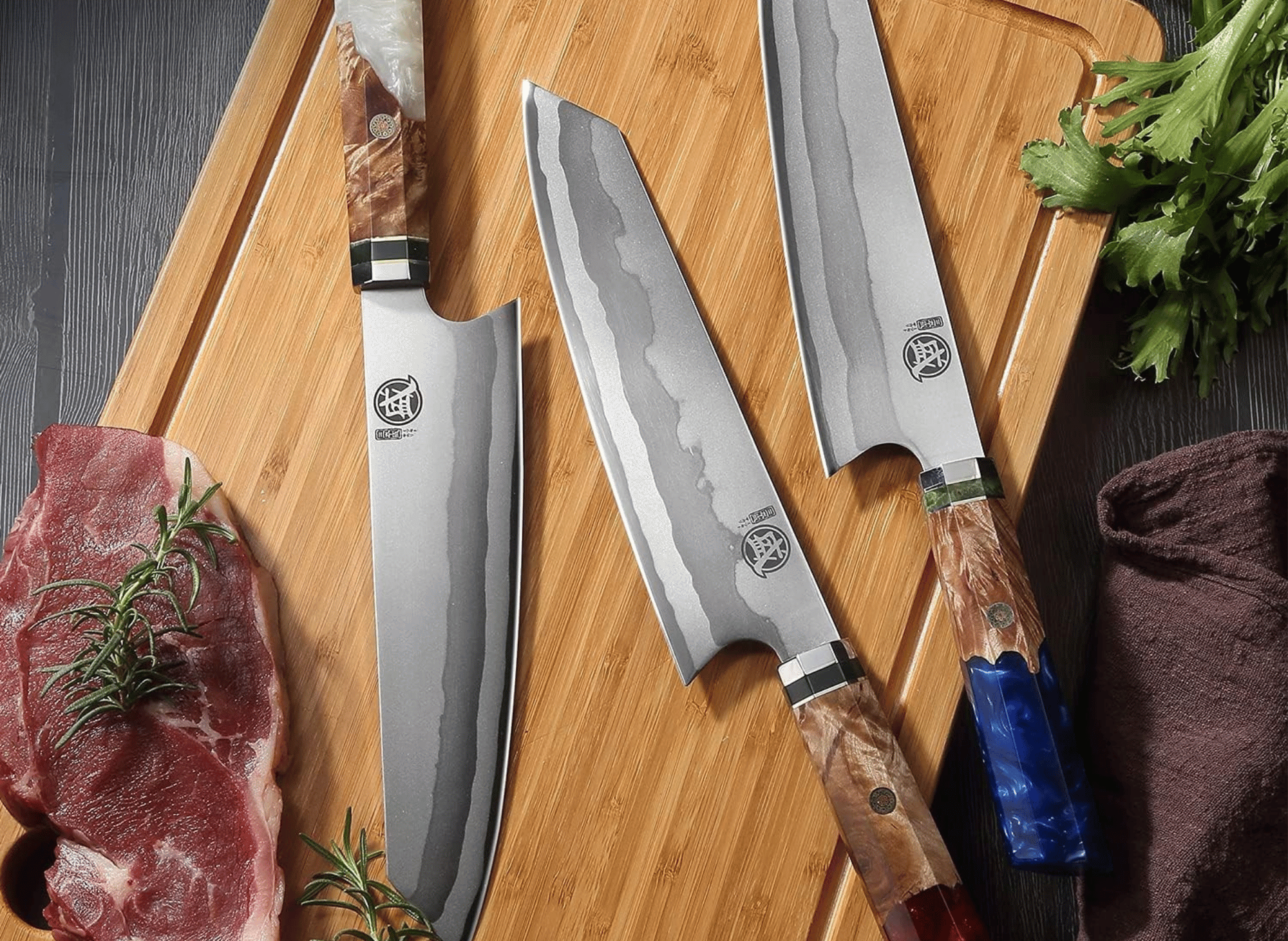
Understanding Steel Quality in Japanese Knives
High Carbon Steel
High carbon steel represents the traditional choice for Japanese knives, offering exceptional sharpness and edge retention. These steels can achieve incredibly fine edges that cut effortlessly through a wide range of ingredients.
Carbon steel knives require more maintenance than stainless options, as they can rust if not correctly cared for. However, many professional chefs prefer carbon steel for its superior performance and the patina it develops over time, which adds character and protection. With proper care, high-carbon steel knives are durable enough for everyday use and can last for generations.
Popular carbon steel types include White Steel (Shirogami) and Blue Steel (Aogami), each offering different performance characteristics. These steels can be sharpened to razor-like sharpness and maintain their edge longer than most Western knife steels.
Stainless Steel
Modern Japanese stainless steels combine corrosion resistance with impressive sharpness and edge retention. Advanced metallurgy has developed stainless steels that rival the performance of carbon steel while offering easier maintenance.
High-quality stainless steels, such as VG-10 and AUS-10, as well as newer powder metallurgy steels, offer excellent performance for both professional and home use. These steels resist staining and corrosion while maintaining the sharp edges for which Japanese knives are known.
High-carbon stainless steel, like that used in GAIFONGRE knives, offers an excellent balance of performance and practicality. This steel type provides superior edge retention and corrosion resistance, making it an ideal choice for busy kitchens.
Damascus Steel
Damascus steel knives feature layered construction that creates distinctive patterns on the blade surface. This technique combines different steel types to achieve optimal performance characteristics while creating visually stunning knives.
The layering process involves folding and welding different steels together, creating a blade with a rigid core for sharpness and softer outer layers for flexibility and durability. This construction method yields knives that are both functional and aesthetically pleasing.
Damascus patterns are not just decorative; they indicate the quality of construction and the skill of the knife maker. These knives often become family heirlooms due to their beauty and exceptional performance.
Handle Materials and Their Impact on Performance
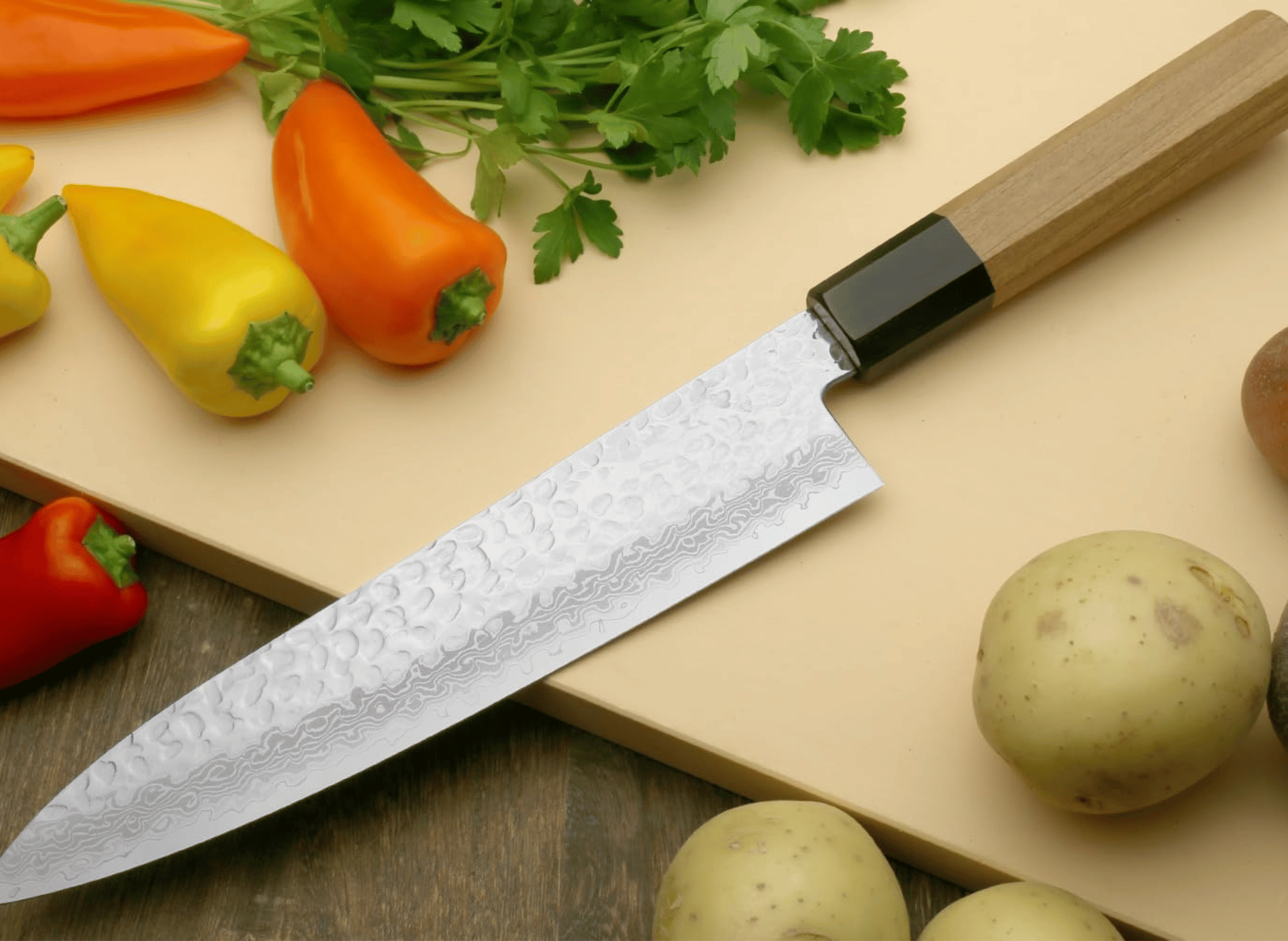
Wood Handles
Traditional Japanese knives feature wooden handles, typically made from magnolia, cherry, or other hardwoods. These handles provide excellent grip and develop character over time as they adapt to the user's hand.
Wooden handles are lightweight and comfortable for extended use. They absorb moisture from the hand, providing a secure grip even when wet. However, they require more care than synthetic materials and should be kept dry to prevent cracking or warping.
The traditional octagonal shape of Japanese wooden handles provides multiple grip positions and prevents rolling when placed on work surfaces. This design has been refined over centuries for optimal comfort and control.
Synthetic Handles
Modern synthetic handles offer durability and easy maintenance while providing excellent grip characteristics. Materials like glass-filled nylon, as used in GAIFONGRE knives, provide strength and resistance to moisture and chemicals.
Synthetic handles can be molded into ergonomic shapes that fit comfortably in various hand sizes. They resist staining, cracking, and bacterial growth, making them ideal for professional kitchen environments.
These handles often feature textured surfaces or contoured shapes that enhance grip security. The consistent properties of synthetic materials ensure reliable performance regardless of environmental conditions.
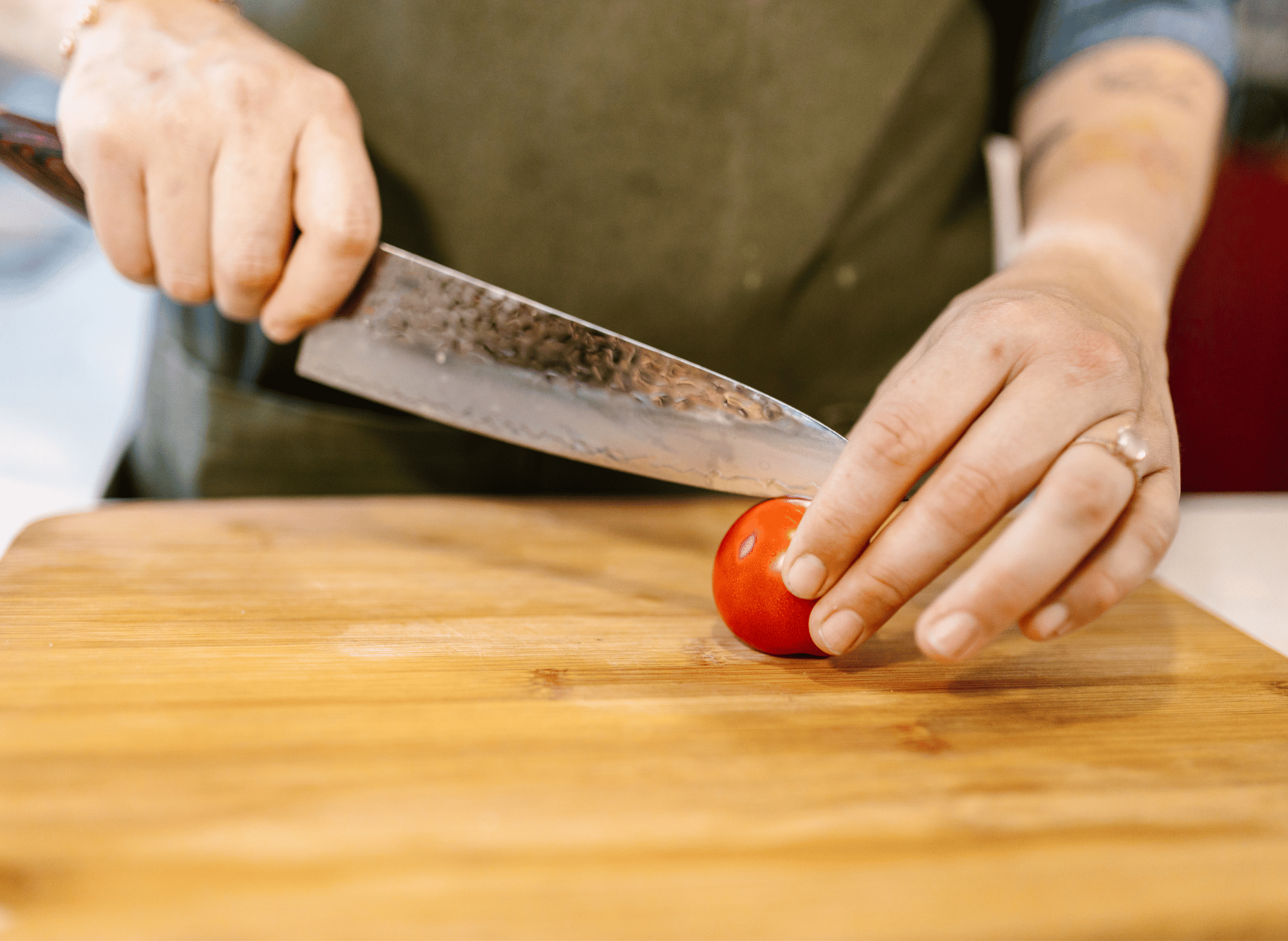
Proper Maintenance for Longevity
Sharpening Techniques
Japanese knives require specialized sharpening techniques and regular maintenance to preserve their exceptional performance. Whetstones are the preferred sharpening method, with different grits used for various stages of the sharpening process.
Start with coarser grits (400-1000) for heavily dulled blades, progress to medium grits (1000-4000) for regular maintenance, and finish with fine grits (6000-8000) for polishing. The sharpening angle typically ranges from 15 to 20 degrees per side for double-bevel knives.
Consistency in angle and technique is crucial for maintaining optimal edge geometry. Many knife enthusiasts find the meditative aspect of sharpening as rewarding as using the knives themselves.
Regular honing with a ceramic rod or leather strop can maintain sharpness between full sharpenings. This maintenance extends the time between major sharpening sessions, keeping knives performing optimally.
Cleaning and Storage
Proper cleaning involves hand washing with mild soap and warm water immediately after use. Never put Japanese knives in the dishwasher, as the harsh detergents and high temperatures can damage both the blade and handle.
Dry knives completely before storage to prevent corrosion. Carbon steel knives may benefit from a light coating of food-safe oil if stored for extended periods. Store knives in protective sheaths, magnetic strips, or knife blocks to prevent damage to the edges. A magnetic knife bar holds Japanese knives securely in place, making it a reliable storage solution.
Avoid cutting on hard surfaces, such as glass, stone, or metal, as these can damage the blade edge. Use wooden or plastic cutting boards to preserve sharpness and prevent chipping.
Clean cutting boards thoroughly between different ingredients to prevent cross-contamination and maintain food safety standards.
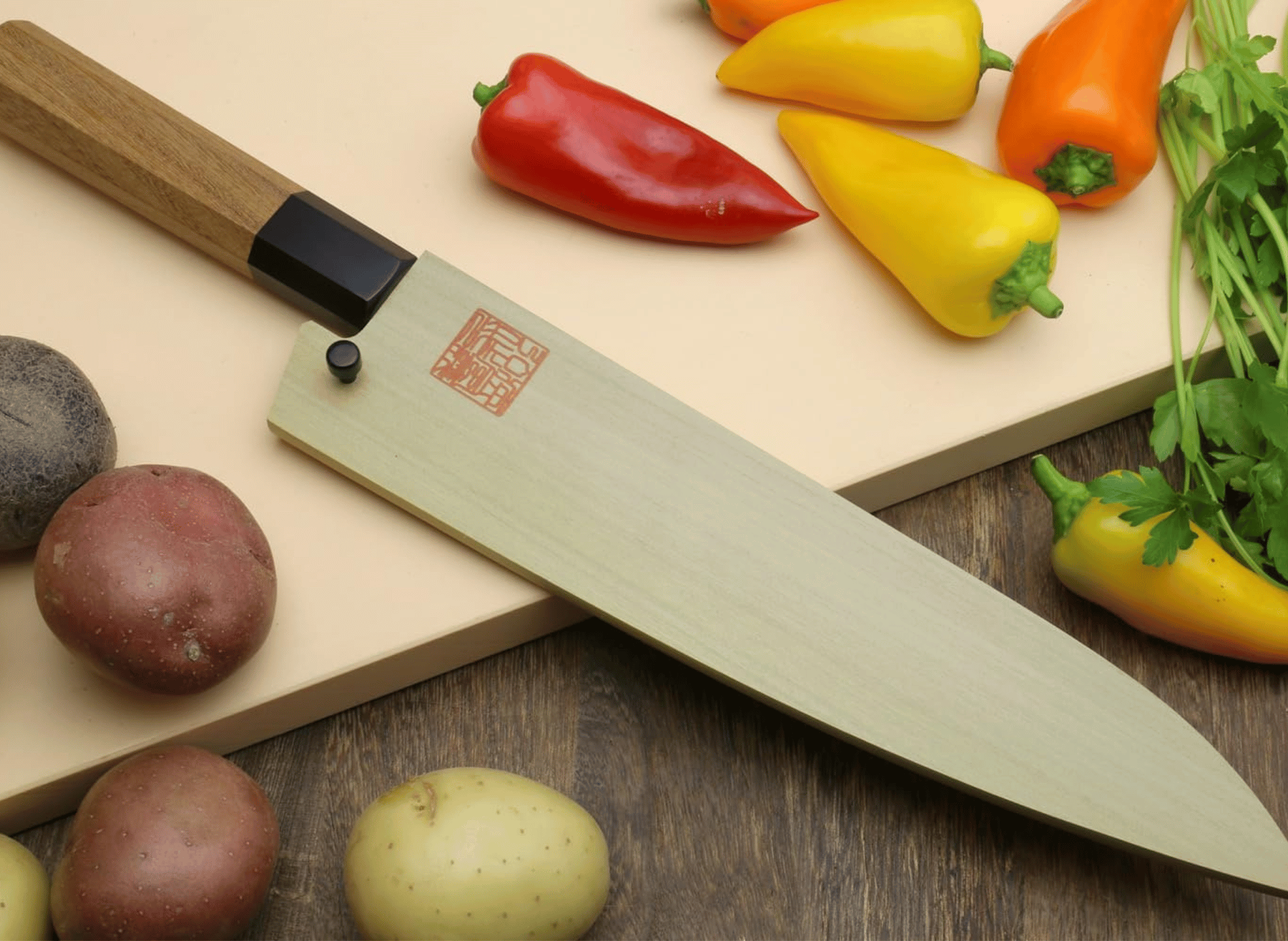
Where to Find Quality Japanese Knives
Reputable knife retailers, both online and in-store, offer authentic Japanese knives accompanied by proper documentation and warranties. These retailers often carry a wide range of Japanese-style knives, including single-beveled and double-beveled options crafted with high-quality steel. Look for dealers who specialize in Japanese cutlery and can provide guidance on selection and care. Many experts recommend purchasing from authorized dealers to ensure the authenticity of the product.
Purchasing directly from Japanese manufacturers or their authorized distributors ensures authenticity and quality. Many traditional knife makers have established international distribution networks to serve global markets.
Knife shows and culinary exhibitions offer opportunities to handle various knives before making a purchase. These events often feature knife makers who can provide detailed information about their products and offer demonstrations on sharpening techniques.
Additionally, online retailers specializing in Japanese knives have become increasingly popular. These websites often feature a wide selection of authentic knives from various manufacturers, along with detailed product descriptions and customer reviews. Many online retailers offer international shipping, making it easy for customers worldwide to access authentic Japanese knives.
With the increasing popularity of Japanese knives for food preparation, there has also been a rise in counterfeit products. As such, it is essential to be cautious when purchasing these knives from unauthorized sources to avoid any potential problems. Counterfeit knives may not only lack the quality and craftsmanship of authentic Japanese knives, but they can also pose safety hazards due to the use of inferior materials and subpar construction.
Proper care and maintenance are essential for ensuring the longevity of your Japanese knife, which has been tested over time. Traditional Japanese techniques for sharpening, honing, and repairing knives utilize water stones, which produce a sharper edge compared to other methods. It is recommended to sharpen your Japanese knife once every 2-3 months, depending on usage.
Additionally, it is essential to store your Japanese knife properly to prevent damage and maintain its sharpness. Avoid storing it in a drawer with other utensils, as this can lead to scratches and dullness. Instead, consider using a magnetic strip or bamboo knife block for storage.
In terms of cleaning, hand washing with warm water and mild soap is the best method for maintaining the integrity of your Japanese knife. Avoid harsh chemicals and never put your knife in the dishwasher, as it can damage both the blade and the handle.
Furthermore, it is essential to sharpen your Japanese knife regularly to maintain its sharpness. This can be done using a whetstone or a ceramic rod designed explicitly for Japanese knives. It is recommended to sharpen your knife every 3 to 6 months, depending on how frequently you use it.
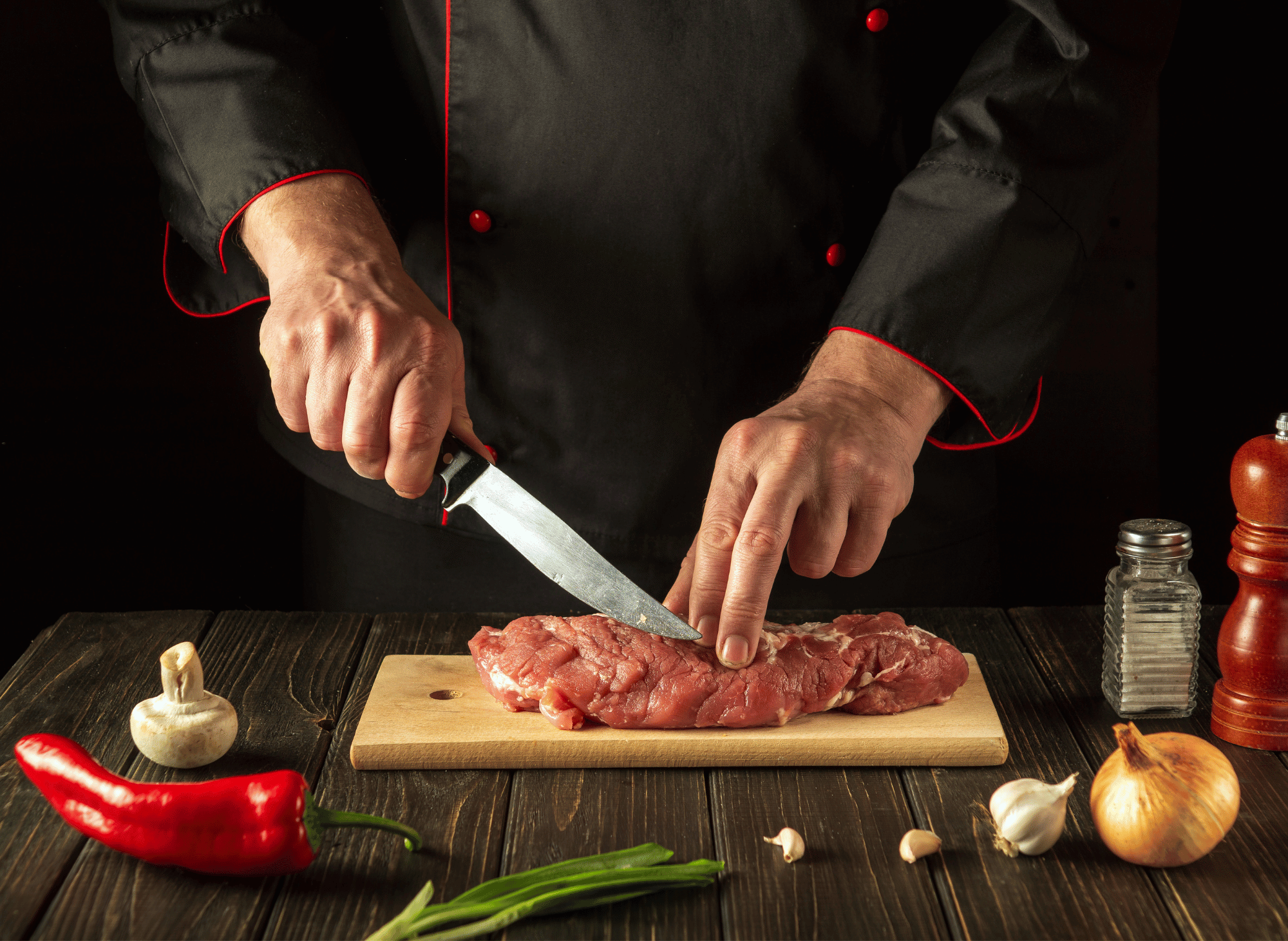
FAQs about Japanese-Style Knives
What makes Japanese-style knives different from Western knives?
Japanese-style knives are typically single-beveled, made with high-quality steel, and designed for precision and sharpness. They often have thinner blades and are ideal for delicate slicing tasks.
What makes Japanese-style knives different from Western knives?
Japanese-style knives are typically single-beveled, made with high-quality steel, and designed for precision and sharpness. They often have thinner blades and are ideal for delicate slicing tasks.
How should I care for my Japanese kitchen knife?
Hand wash with mild soap and water, dry immediately, and store safely. Regular sharpening with a water stone is recommended.
Which Japanese knife do you recommend for beginners?
A Gyuto (Japanese chef’s knife) is highly recommended for its versatility and ease of use.
Do Japanese knife retailers offer international shipping?
Yes, many reputable retailers provide international shipping, allowing customers worldwide to purchase authentic Japanese knives.
Popular Knife Brands
When it comes to Japanese knife brands, names like Mac, Miyabi, Shun, Global, and Tojiro stand out for their quality and innovation. Each brand offers a unique selection of knives, from traditional Japanese styles to modern interpretations.
Miyabi is renowned for its razor-sharp edges and elegant craftsmanship, while Mac is celebrated for its lightweight, versatile chef’s knives that deliver outstanding performance. Shun’s knives are known for their intricate designs and exceptional beauty, making them a favorite among collectors and chefs alike.
For those seeking great value, Global and Tojiro provide high-quality, entry-level options that don’t compromise on performance. No matter which brand you choose, even the more expensive Japanese knives hold a proud place in the world of cutlery, offering a perfect blend of beauty, functionality, and lasting performance.
Always shop and compare the sale price to the regular price, and look for free Prime shipping to receive your next amazing box in the mail.
Thank you for reading!
Your friend,
Kelly
#JapaneseKnife #KitchenTools #CookingEssentials #ChefKnives #SharpBlades #CulinaryArts #KnifeCraftsmanship #CookingGear #QualityKnives #MadeInJapan
🔪🍣🍴🥢🍜🇯🇵🔥🧑🍳✨
Amazon Prime offers a wide range of products designed to cater to diverse customer needs, all with the added benefit of fast, reliable delivery. From household essentials and groceries to electronics, clothing, and entertainment, Prime members get access to exclusive deals and discounts across various categories.
Additionally, Prime membership includes access to services like Prime Video for streaming movies and TV shows, Amazon Music for ad-free music, and Prime Reading for eBooks and magazines. This comprehensive suite of benefits makes Amazon Prime a convenient and value-packed option for millions of customers worldwide.
- Prime for you, adult
- Free 30-day trial of Prime
- All of Prime, half the price.
- Prime Video
- Wedding Registry
- Kindle Unlimited
- Amazon Music
- Amazon Fresh Groceries
